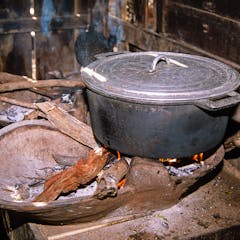Polluting cooking fuels are still preferred in parts of Africa. Alan Morgan/FlickrHousehold air pollution from cooking, heating and lighting with fuels like wood, charcoal and kerosene poses a substantial global health problem.
Globally, 2 billion people cook with polluting fuels and are exposed to high levels of household air pollution. The highest proportion live in sub-Saharan Africa, where about 900 million people cook with polluting fuels.
Studies have shown that use of cleaner cooking fuels, like electricity, ethanol and liquefied petroleum gas, reduces exposure to fine particulate matter (PM2.5), a damaging pollutant. But other studies have also shown that the use of cleaner cooking fuels doesn’t necessarily reduce PM2.5 levels in people’s homes.
To understand why, our research looked at three rapidly urbanising communities in Cameroon (Mbalmayo), Ghana (Obuasi) and Kenya (Eldoret). We looked at differences in air pollutant levels across cooking fuel types as well as other environmental factors. We measured levels of PM2.5 as well as carbon monoxide (CO), another damaging air pollutant.
Half of the households that were part of our study were mostly cooking with LPG, which is considered a cleaner cooking fuel. The other half were cooking only with polluting fuels, including wood and charcoal.
Our findings showed that the type of cooking fuel households used did indeed affect levels of pollution inside people’s homes. But we found wide disparities between the three communities. For example, there was hardly any difference in average PM2.5 exposures between LPG and charcoal users in the Ghanaian setting. However, in the Kenyan and Cameroonian communities, women’s average PM2.5 levels were much higher among those cooking with wood, compared with those cooking with LPG. In Eldoret, Kenya, women cooking with charcoal were also exposed to substantially higher levels than those cooking with LPG.
We concluded from our results that this could be explained by the fact that environmental factors were also at play – air pollution levels outside people’s homes. In the Ghanaian area, outdoor air pollution levels were around double the levels in the other two communities. This difference is likely due in part to increased levels of Saharan dust in Ghana during the harmattan season.
In addition, most women in the Ghanaian setting usually cooked outdoors on a veranda. This increased their exposure to outdoor air pollution. In contrast, women in Kenya and Cameroon typically cooked indoors.
We also found that women, regardless of the cooking fuel they used, had higher exposure to PM2.5 if they lived closer to a busy road (less than a five minute walk away) and travelled outdoors during the day. This suggested that traffic emissions probably made up a substantial proportion of the air pollution that women were breathing in these urban areas. And emissions generated from cooking might have contributed less to overall PM2.5 exposures.
This may explain why there were minimal differences between PM2.5 exposures among women using LPG and charcoal stoves in the Ghanaian community, despite LPG stoves generally emitting lower levels of PM2.5. It follows that, in some areas with rapid urbanisation, outdoor air pollution is probably lowering the ability of clean cooking fuels to reduce PM2.5 exposures.
What next
As cities continue to urbanise and the African population increasingly migrates to cities, evidence points to the fact that localised levels of air pollution from industrial sources, traffic, and trash burning are likely to increase. This means that people will become increasingly exposed to air pollutants outdoors and that reductions in PM2.5 exposure that happens when people switch from polluting fuels to LPG may be lower.
Our findings show that clean cooking fuels can reduce indoor air pollution. However, a focus on reducing indoor pollution by switching cooking fuels may only have a limited effect on people’s exposure to damaging air pollutants. Our findings point to the need for developing strategies for reducing both indoor and outdoor air pollution levels. Lower outdoor PM2.5 concentrations can be achieved through stricter regulations on traffic emissions and limiting or eliminating trash burning in favour of less polluting methods for solid waste disposal.
Nevertheless, efforts to encourage a transition towards clean cooking fuels should remain an important policy priority, particularly in communities that are exposed to lower levels of outdoor PM2.5. The transition to clean cooking fuels can potentially have a greater health benefit in these settings.
A more targeted approach and prioritising certain areas in the drive for access to cleaner cooking fuels makes sense. As the Clean Cooking Alliance has pointed out, there are limited resources and funding to tackle the move towards cleaner cooking fuels. Targeting specific areas for clean cooking transitions may therefore be a useful strategy.
In the meantime, the global health community must devote more resources to providing universal access to clean cooking by 2030 (United Nations Sustainable Development Goal 7)].![]()
Matthew Shupler, Postdoctoral Research Associate in Environmental Public Health, Harvard University; Esong Miranda Baame, PhD Candidate, Université de Dschang, and Theresa Tawiah, Health Economist ,Department of Environmental Health, Kintampo Health Research Center
This article is republished from The Conversation under a Creative Commons license. Read the original article.


